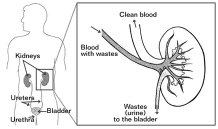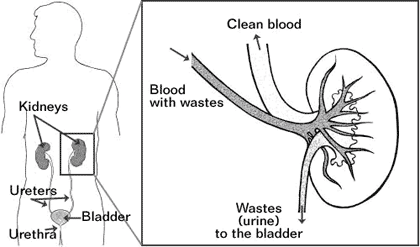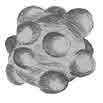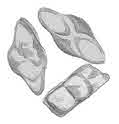Part-II: Understanding Incontinence
2. What is Incontinence?
When you are not able to control your urination, it is urinary incontinence. It is the same as uncontrollable urination or loss of bladder control. Such inability could occur on rare occasions or you could have a total inability to control your urination.
The first time I had incontinence was after my 9 pound 9 ounce son was born.
For months, every time I laughed, tried to run or jump or sneeze, I'd wet.
There is no elegant way to say it, really. You simply cannot control your bladder. My doctor told me it would go away on its own. Then I found out about Kegel exercise and those helped a lot. Still, my doctor said that they would go away.
I wanted to study more about it, as I found it inconvenient and embarrassing.
The main organs controlling your urination are your bladder, muscles and nervous system. Muscular tissues of your bladder and urethra combine with different voluntary muscles of your skeletal system and nervous system.
Together they regulate passage of urine. Sometimes these muscles are unable to function normally due to certain physiologic, pathologic, or anatomical abnormalities. You may also encounter problem of urinary incontinence due to different specific muscular disorders or congenital disorders like multiple sclerosis, spina bifida, and ALS. Hence, you are unable to store or control passage of urine.
Copyright 2005 All rights reserved
- 10 -
“Understanding INCONTINENCE’ by G. Fairweather
Page 11 of 94
Urinary incontinence in infants and children below six years old is normal, as they are yet to develop complete toilet habits. Such young children may also wet their beds at night. Some children suffer from infections and anatomical irregularities in the urinary tract, nervous disorders, or spinal injuries resulting in urinary incontinence. Some young girls may have slight urinary seepages while laughing.
The majority of the problem of urinary incontinence is high among elderly people, especially with women. Though this is not a major problem, yet it is better to seek advice of urologists and gynecologists. They can assess the severity of the issue and treat it accordingly.
===\\\===\\\===\\\===\\\===\\\===\\\===
Copyright 2005 All rights reserved
- 11 -
“Understanding INCONTINENCE’ by G. Fairweather
Page 12 of 94
3. Physiology and Function of
the Bladder and Urinary Tract?
Your urinary system with the help of different organs ensures normal
excretion of urine from your body. When such normal excretion does not take place, you suffer from urinary incontinence.
Physiology of Urinary System
Kidneys, bladder, ureters, and urethra constitute your urinary system. Your hipbones in your pelvis region encompass the urinary bladder behind the pubic bone. This muscular and hollow sac in the shape of a balloon stores urine.
Strong and fibrous tissue keeps your urinary bladder intact maintaining contact with other pelvic organs. Normal storage capacity of your bladder is around sixteen ounces for around two to five hours. The urethra is a tubular structure, which flushes out your urine through the bladder. It opens into the bladder through bladder neck.
Male and Female Urethra
The urethra in women is approximately four centimeters long, starting from the bladder neck to the vaginal opening. It has many smooth muscular fibers, sphincter fibers, mucous membrane, and a layer of elastic tissue. Collagen tissue keeps all these fibers together.
The male urethra is around eight to nine inches long from the bladder neck to the end of the penis. Three main parts of the male penis are prostatic, spongy, and membranous.
Copyright 2005 All rights reserved
- 12 -

“Understanding INCONTINENCE’ by G. Fairweather
Page 13 of 94
Ö Membranous part is around three-quarter of an inch between triangular parts of pelvis region.
Ö Prostatic, widest part of penis consists of muscular fibers, fibrous tissue, and many glandular openings connecting to prostate gland.
Ö The longest part of male urethra is the spongy part, through the entire penis until the glands at the tip of penis. Corpus spongiosum
encompasses and protects the male urethra.
Working of your Urinary System
Your body absorbs essential nutrients from
your food to maintain your health, provide
energy, and restore injured tissues. Your
body absorbs the moisture content from
your solid and liquid diets. Your urinary
system removes waste products, specifically urea from your body fluids.
Digestion of protein rich foods like poultry, some vegetables, and meat forms urea, which passes into your kidneys through blood. They combine with other waste products and water to form urine. Kidneys are bean shaped organs mainly responsible for excretion of waste products from your body.
A human adult forms and excretes around one and half quarts of urine every day. This quantity varies from individual to individual. It depends on intake of fluids and food, fluids lost through breathing and sweat, and intake of diuretics and other medicines.
The urine flows out from kidneys into ureters to enter the urinary bladder.
Every ten to fifteen seconds a few drops of urine accumulate in your urinary Copyright 2005 All rights reserved
- 13 -
“Understanding INCONTINENCE’ by G. Fairweather
Page 14 of 94
bladder. When the bladder becomes full and round, your body needs to excrete urine. The brain signals the urinary system to relax to allow flow of urine out of your body through the urethra. This is a normal process in continent persons, who can control excretion of urine.
Urethral sphincter muscles keep the urethra closed until you are free to urinate.
Pubococcygeus (PCG) muscles enclose the urethra to stop unwanted seepage of urine. Bladder muscles tighten and contract to push out urine from your body only when you feel the pressure of urination. Relaxed sphincter and pubococcygeus muscles allow normal urination. However, if you are unable to control the urination process, you suffer from urinary incontinence.
===\\\===\\\===\\\===\\\===\\\===\\\===
Copyright 2005 All rights reserved
- 14 -

“Understanding INCONTINENCE’ by G. Fairweather
Page 15 of 94
Kidney Stones
Your Kidneys
Your kidneys are bean-shaped and each is about fist-size. They sit near the middle of your back, just below the rib cage. They gather your body’s waste.
Every day, your kidneys ‘harvest’ about 2 quarts of waste products and extra water from your bloodstream which becomes urine.
That goes through ureter tubes to your bladder where it is stored until expelled.
Your kidneys also help control blood pressure and to make red blood cells.
What is a Kidney Stone?
A kidney stone is a lump formed in the kidney from waste in the urine.
Small stones may be expelled in the urine without much pain. But larger stones may stick in a ureter, the bladder, or the urethra and then block the flow of urine, causing intense pain.
Copyright 2005 All rights reserved
- 15 -



“Understanding INCONTINENCE’ by G. Fairweather
Page 16 of 94
Types of Kidney Stones
There are four main types.
1. The most common type contains calcium (KAL-see-um). Calcium is an essential part of your healthy diet but any which isn’t used by your body for your bones and muscles goes to your kidneys.
a. Mostly, they flush it out in your urine. If all the calcium is not flushed, it combines with other waste products and calcium
kidney stones result.
2. A struvite stone sometimes forms after a urinary system infection.
They contain magnesium and waste ammonia.
3. A uric acid stone may form if there is too much acid in the urine. If you get uric acid stones, you may need to cut down on the meat you
eat.
4. Cystine stones are uncommon. Cystine is a component needed for you to build muscles, nerves etc., but it can build up in the urine to become a stone. This condition is hereditary.
Examples of Kidney Stones
Kidney stones may be smooth or bumpy, are usually yellow or brown and vary in size from a small grain to pearl-size though occasional ones can be as big as a golf-ball. These examples are not to size:
Copyright 2005 All rights reserved
- 16 -
“Understanding INCONTINENCE’ by G. Fairweather
Page 17 of 94
Some Available Treatments
If you have a stone and cannot pass it, consult your doctor as soon as possible.
Surgery used to be the only way to remove it. However, research is ongoing.
Here are some of the current methods;
Shock Waves
Doctors send shock waves to the kidney stone. They break large stones down to a size which will pass with your urine.
With some machines, you sit in a tub of water, while you lie on a table with other machines.
This method is called extracorporeal lithotripsy. Lithotripsy is a Greek word that means stone crushing.
Tunnel Surgery
The doctor makes a small cut in your back and a narrow tunnel through the skin to the stone in the kidney. Then, the doctor puts a special instrument through the tunnel, finds the stone and removes it. This is percutaneous nephrolithotomy.
Ureteroscope
A ureteroscope is like a long wire. The doctor puts it into the patient's urethra, up through the bladder to the ureter where the stone is. The instrument has a camera that lets the doctor see the stone. Then, either a cage is used to catch the stone and pull it out, or the doctor may destroy it right there.
How Doctors Identify the Stone
If you know that you are passing a stone, try to catch it in a strainer. Seeing the stone is the best way for your doctor to identify what kind of stone you have and it is also the easiest on you.
Your doctor may ask for a urine sample (or you may need to collect your urine for a 24-hour period) or take blood to find out what causes your stones. These tests help your doctor suggest how you might avoid stones in future.
Copyright 2005 All rights reserved
- 17 -
“Understanding INCONTINENCE’ by G. Fairweather
Page 18 of 94
The Type of Stone Indicates the Best Treatments
The therapy your doctor gives will depends on the type of stone. Treatment to prevent calcium stones will not work on struvite stones. Diet changes to help prevent uric acid stones might not affect calcium stones.
Avoid More Stones
Drink more water. Try to drink 12 full glasses of water a day. This helps to flush your kidneys more thoroughly and has other benefits for your whole system.
You can drink ginger ale, lemon-lime sodas, and fruit juices but water is best.
Limit coffee, tea, and cola to one or two a day - the caffeine may cause too much fluid loss.
Your doctor may advise increasing your intake of some foods and cutting back on others. If you have a uric acid stone, you may have to eat less meat.
The doctor may give you medicines to prevent calcium and uric acid stones.
Important Points
• Most stones will pass out of the body without a doctor's help.
• See your doctor if you have severe pain in your back or side that will not go away.
• See your doctor if you have blood in your urine (it will appear pink).
• Drink plenty of water every day to prevent more kidney stones.
• If you pass a stone, try to collect it with a strainer to show your doctor.
• Talk to your doctor.
Copyright 2005 All rights reserved
- 18 -
“Understanding INCONTINENCE’ by G. Fairweather
Page 19 of 94
4. Signs of Incontinence
When you are unable to control the passage of urine, be it a small leakage or a total lack of control over urination, it is urinary incontinence. This can occur in men, women, or children. However, children below six years old do not fall under this category, as they are yet to develop total toilet habits. Elderly people encounter this frequently.
Urinary incontinence occurs due to various reasons. These can be tumors, kidney stones, infections of the urinary tract, nervous disorders, spinal cord injuries, weak pelvic muscles, prostate cancer, or due to different medications.
Signs of Incontinence
There are many symptoms or signs of urinary incontinence. These depend on your stress levels, urges to urinate, or due to certain weak muscles of the pelvic region of your body. The many symptoms are:
Ö Leakage of urine while laughing, coughing, exercising, running, lifting heavy things, or sneezing
Ö Urine continues to trickle even after urinating and leads to a continual leakage of urine
Ö Urge for urination continues even after urinating
Ö Very difficult to control flow of urine as soon as you feel the urge to urinate
Copyright 2005 All rights reserved
- 19 -
“Understanding INCONTINENCE’ by G. Fairweather
Page 20 of 94
Ö Feeling of urination during sexual intercourse
Ö Frequent toilet visits during daytime and nighttime
Ö Frequency of urination is higher
Ö Urge to urinate even when the bladder is not full
Ö Feel pain while urinating or also while filling the bladder
Ö When you change your sitting or any posture, you feel the urge to urinate Ö Urine leakages after major surgeries like Cesarean, prostate surgery, hysterectomy, and others
Ö Urinary changes after neurological disorders like spinal cord injuries, multiple sclerosis, or strokes
Ö Frequent urinary bladder infections
Ö Unable to retain urine even for short periods
Ö Urine leakages causing much embarrassment and hinder your normal
functioning
Ö Gradual weakening of urinary system and its functioning
Ö Urinating with stoppages thereby restricting continuous flow of urine Ö Constant feeling that bladder is full and you want to urinate
Copyright 2005 All rights reserved
- 20 -
“Understanding INCONTINENCE’ by G. Fairweather
Page 21 of 94
Ö Weak pelvic floor muscles put a strain on your urinary system and you feel like urinating, situation is common in obese people, after childbirth and with age.
Ö Enlarged prostate gland also causes problems in urination.
Normally signs of incontinence have many cures and treatments. Medications, minor surgeries, and exercises for pelvic muscles offer much relief. You can use pads. The pads that are made nowadays are so much better than the old days. They are thinner, and absorb more.
You can easily change them and you can wear them undetected.
However in some cases, the problem is quite bad, and a urinary catheter can be used in those extreme cases. Sometimes overall improvement in your health may improve these signs of incontinence.
The incontinence signs also differ for men and women. Normally women
suffer from urinary incontinence due to various stresses while men suffer problems of incontinence due to weak muscles and other functional stress.
Functional stress does not allow you to reach the toilet due to certain medical conditions like physical infirmities, dementia, or other problems. Women suffer soon after childbirth or other stressful periods. Obese people often encounter problems of urinary incontinence. Hence symptoms or signs of incontinence depends more on the type of incontinence.
===\\\===\\\===\\\===\\\===\\\===\\\===
Copyright 2005 All rights reserved
- 21 -
“Understanding INCONTINENCE’ by G. Fairweather
Page 22 of 94
5. Types of Incontinence
Urinary incontinence is your inability to control the passage of urine. There are many different types of urinary incontinence. Different types have different medications to relieve you of the problem. The two broad classifications of urinary incontinence are:
1. Short-term or Acute Incontinence
2. Long-term or Chronic Incontinence
Constipation, urinary tract infections, side-effects of medication or diets, or kidney stones could cause acute urinary incontinence. This is a temporary phase and finds easy remedy in simple medications. This is the same as transient incontinence.
Long-term or chronic incontinence is over a longer period. Such chronic incontinence could be due to stress, urge, overflow, functional, reflex, anatomical, surgery-induced, or mixed urinary incontinence.
Stress Incontinence
This is common incontinence in women. When you have slight and
involuntary urine leakages while doing any physical activity, it is stress incontinence. The stress here does not refer to any emotional stress, instead is the physical exertion in the abdomen regions. Simple activities like sneezing, coughing, laughing, exercising, hugging, lifting anything, walking, changing positions like getting up from a chair or lying on a bed, and sexual actions Copyright 2005 All rights reserved
- 22 -
“Understanding INCONTINENCE’ by G. Fairweather
Page 23 of 94
could cause such involuntary urinary leakages. You may have to visit the toilet often to prevent such urinary leakages.
Causes
1. The main cause behind this incontinence is unequal abdominal pressure upon urinary bladder and urethra. This cause urethra and bladder neck
to proceed downwards and weak pelvic floor muscles change direction
of the urethra. This keeps the urethra open and urine leaks out. Pelvic muscles normally support the urinary bladder.
2. Weak urethral sphincter muscles are unable to absorb abdominal
pressure and thereby cannot prevent urinary flow. This weakness is due to neurological injuries, side effects of certain medicines on the urethral region and surgeries. This causes incontinence in men after prostate
surgery while in women after pelvic surgery. Women with multiple
pregnancies or vaginal childbirths, or when the urethra or bladder or
rectal wall extends into vaginal space, stress incontinence is common.
3. Chronic asthma and bronchitis cause incessant coughing leading to
stress incontinence.
4. Menopause- During menopause there is a decrease in female hormones leading to weakening of supporting muscles of the pelvic region.
Incontinence is also evident during the week before a menstrual period.
The low estrogen levels in your body now lead to less muscular
pressure in the urethra region, which leads to involuntary urinary
leakages.
5. Increasing age, smoking, and obesity are other factors.
Copyright 2005 All rights reserved
- 23 -
“Understanding INCONTINENCE’ by G. Fairweather
Page 24 of 94
Classification of Stress Incontinence
Urologists normally classify stress incontinence into three main types.
In the Type I category the bladder neck and urethra open and the urethra moves down by less than two centimeters during any stress. Hence, the urethra angle is unchanged. Such categories of patients do not exhibit any cystocele signs.
In the Type II category, the bladder neck and urethra close and urethra moves down by more than two centimeters during any stress. Hence, the urethra angle increases and such patients could have a cystocele. If such a cystocele is within the vagina, it is Type II A and if it is outside the vagina, it is a Type II B.
In the Type III category, stress incontinence is not due to the urethral position. It is normally due to weak urethral sphincter muscles, which could be due to past surgeries.
Treatments
Stress incontinence is fully treatable and there are many simple cures for the same.
Pelvic floor exercises: Such exercises according to your doctor’s instructions give immense relief from incontinence to both men and women.
Surgery: A hysterectomy by a gynecologist can provide relief.
Pessary: This device in the vagina provides support to the urinary tract and other organs. Often, this is an alternative for surgery.
Copyright 2005 All rights reserved
- 24 -
“Understanding INCONTINENCE’ by G. Fairweather
Page 25 of 94
Hormone Replacement Therapy: This is useful for menopausal women.
Application of hormone replacement therapy cream around the urinary opening also provides relief.
Urge Incontinence
This incontinence is common in both elderly and healthy men and women.
This is a type of incontinence where you are unable to control your urine as soon as you feel the urge to visit the bathroom. Your urinary bladder becomes overactive and gives less warning for you to go to the toilet. The bladder squeezes itself involuntarily and may empty itself fully or you might have little urine leakages. The bladder may or may not be full at the time of such an occurrence.
You feel the urge to urinate when you drink a little quantity of water, or hear the sound of running water as in a shower, running tap, washing dishes, or flushing sound, or even touch running water. You need to visit the bathroom two or three times in the night. Additionally you might also wet your bed at night.
Causes
The common causes are:
1. Inappropriate bladder contractions due to severe nervous damage to your bladder- Such damage occurs due to spinal cord and nervous
injuries, Alzheimer's disease, Parkinson's disease, stroke, multiple
sclerosis, and other surgical injuries. These cause harm to the bladder nerves and muscles.
2. Constipation also causes urge incontinence.
Copyright 2005 All rights reserved
- 25 -
“Understanding INCONTINENCE’ by G. Fairweather
Page 26 of 94
3. Infections of the urinary tract cause irritation producing muscular spasms in the urethra and bladder regions.
4. Enlarged Prostate gland
5. Change in sitting or sleeping positions
Bladder retraining is the most common treatment for urge incontinence.
Overflow Incontinence
This type of incontinence is common among elderly men and rare in women.
You do not feel the urge to urinate although your bladder is full. Hence, urine leaks out in small quantities continuously and your bladder never empties fully. It is always partially full.
You wake up many times to urinate at night and at times pass a constant stream of urine although you have been to the toilet for a long time. Hence, you never feel that your bladder is empty.
Causes
Possible causes of Overflow incontinence are:
1. Enlarged prostate gland stops the flow of urine in many men.
2. Tumors or kidney stones block the urethra and hence the flow of urine.
3. Diabetes and other nervous system diseases like Parkinson’s disease, Alzheimer’s disease, strokes, and multiple sclerosis damage the nerves of the bladder muscles and make them weak, causing such
incontinence.
Copyright 2005 All rights reserved
- 26 -
“Understanding INCONTINENCE’ by G. Fairweather
Page 27 of 94
4. Nervous system disorders and spinal cord injuri








